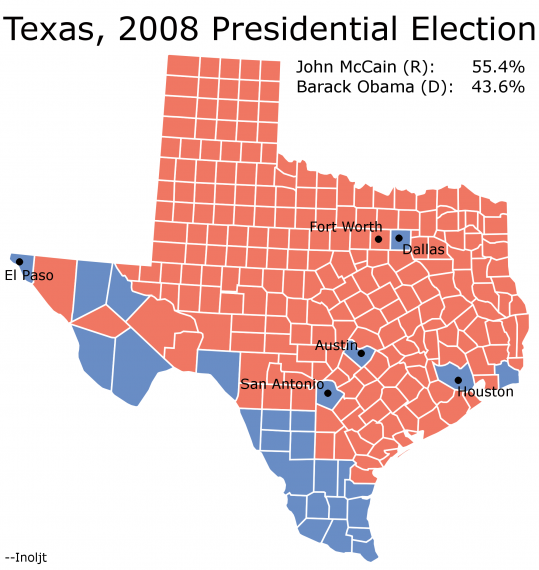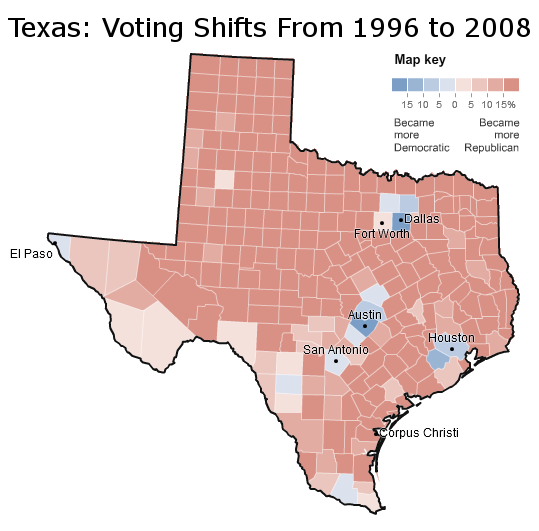By: Inoljt, http://mypolitikal.com/
The state of Texas is one of the Republican Party’s most valuable strongholds. It adds a good 38 electoral votes to the Republican candidate’s electoral vote; Democrats have not been competitive in the state for at least a decade.
One of the only Democratic regions in Texas lies along the Rio Grande River:
More below.
This region is the part of Texas that borders Mexico. It is readily apparent in the map above as the only group of blue counties that President Barack Obama won outside of a major city.
The area is one of the most Hispanic areas in the United States; there are places, especially next to the border of Mexico, where the Hispanic percentage approaches 100%. Some of these people have lived along the Rio Grande for hundreds of years, with roots dating back to when Texas was a part of Mexico.
There are several other distinguishing characteristics. The parts of Texas along the Mexican border are among the poorest regions in the United States. Politically speaking, voter turn-out is very low – perhaps lower than any other part of the country.
When the rest of Texas moved steadily Republican, South Texas swung leftwards for much of the twentieth century. In 1996 the Democratic presidential nominee won almost every single county south of San Antonio, some with over 80% of the vote.
Since then, however, Republicans have recovered their verve. President George W. Bush did incredibly well amongst Hispanics in Texas; in 2004 he even won 86% Hispanic Cameron County in the Rio Grande Valley. In 2008 the Democratic presidential candidate once again posted solid numbers along the Rio Grande. Nevertheless, they ran well behind their 1996 performance throughout the region:
(Note: Edited NYT Image)
Compared to 1988 – a year in which the Democratic presidential candidate suffered a resounding national defeat – the 2008 nominee, despite winning a solid national victory, also failed to improve markedly in the Rio Grande area:
(Note: Edited Center For American Progress Image This image can be accessed here.)
Note that in 2008 Democrats lost Texas by 11.8%; in 1988 they lost Texas by 12.6%.
In the 2010 midterm elections Republicans also made several gains in South Texas, winning two heavily Hispanic congressional districts. The first was the 23rd congressional district, which is 65.5% Hispanic; the second the 27th congressional district, which is 71.6% (!) Hispanic.
These patterns are not unique to Texas. In rural south Colorado, for instance, traditionally Hispanic counties have also trended Republican since the 1990s.
Whether the areas of Texas bordering the Rio Grande River will continue moving Democratic or Republican is up-to-question. In Texas, the effects of Mr. Bush’s appeal to Hispanics still are heard; Hispanics in the state are some of the more conservative in the country. The Texas Republican Party has also been relatively moderate on immigration issues. For instance, Republican Governor Rick Perry – a firecracker on other issues – opposes SB 1070.
Needless to say, Republican success at cutting Democratic margins in the counties bordering the Rio Grande would constitute a major achievement for the party.
If a Democrat is ever to win Texas – and none has done so for more than a decade – he or she will need enormous margins there. If Republicans go from 30+% to 40+% of the vote in El Paso or Hidalgo County, it is very difficult to imagine Democrats ever winning Texas.
For more than a decade Democrats have latched onto the Great Hispanic Hope: that growing numbers of Democratic-voting Latinos in Texas will one day turn the state blue. Republican success at winning Hispanics would crush that dream.




from the 2008 primary. It seems that if the Democrats could get that kind of turnout in a midterm, they could be (possibly) competitive in a midterm.
But I think it will take 15-20 years to see any regular Democratic wins.
The TX GOP adopted on its platform a resolution in support of the state adopting an AZ-like immigration policy several months ago. So, that’s not going to help them and with the inmates running the asylum, all bets are off.
Also, although the Hispanic population in TX votes more Republican than in say, AZ or CA, it would be innacurate to call them the most GOP-voting in the nation. Late last year, Perry got 35% of the Hispanic vote to 65% for White. Compare that to the <30% McCain got in that same election and the ~30% Whitman got and then look at FL where Rubio got ~60% of the Hispanic vote (albeit in a year with low Dem turnout).
The issue with Dems in Texas is the collapse of the old coalitions and the lack of massive effort to build a new one. Voting levels among Texas Hispanics is probably the lowest in the nation and is down in the 30’s. There’s a gold mine out there, but the TX Dem Party has yet to have the resources to carry out such a venture. And in the Rio Grande region, the Dems have a poor bench (it’s not small, just uninspiring), which probably explains why they are not doing better there.
Finally, the Dems still can easily win back TX-23 and TX-27. Farenthold will be given one of the new districts tailored for him and the Dems could run Gallego (one of the few Dem rising stars outside of the cities) against Canseco.
I know this was talked about kind of in the background during 2008, but 2008 isn’t the best year to judge much of anything (and neither is 2010). I want to be sensitive, here, but there was a real issue with race/ethnicity in terms of hispanics and Obama, at least starting out when the media tried to dredge up the historic complicated relationship between blacks and hispanics, not to mention that Hillary (whose husband was wildly popular in the Rio Grande) stayed in the primary race so long and John McCain historically having been at the very least not very hostile to the community and coming from a border state, himself. All of this certainly effected 2008 in a way I’m not sure makes it a good year for comparison to anything.
No pun intended.
Please consider cross-posting this diary at RRH. I think it fits in very well with the themes of Imperial’s Minority Report series. Great work!
has been the absolute collapse of Democratic strength across the rural areas in the north, central, and eastern parts of the state. McCain actually topped Bush’s margins over Kerry in quite a few of them. Unbelievable. The Rio Grande counties more or less stayed even. What allowed Obama to get within 12% of McCain was the continuing trend of Democrats pulling ahead in the metro cities. Eventually, Texas will be competitive simply by virtue of the Democrats running up the vote in Houston, the Dallas-Forth Worth area, Austin, San Antonio, and El Paso. But we didn’t come as close as Clinton did to winning Texas because of the formerly competitive, rural white counties embracing Republicans, a trend that has become apparent in neighboring Louisiana, Arkansas, and Missouri for awhile now.
Texas Republicans have had a good relationship with their Latino population for awhile now…Bush is the poster child for a conservative Republican that is eager to work with Latinos and try to bring them into the party. But I think his type of Republican is the one of the past, and it’s only a matter of time before the TX GOP does something to massively piss off their Latino residents. And when that happens, Texas won’t be such a lock for them anymore.
the possibility that the majority of the people voting in these counties are whites because the non-white voters aren’t showing up, if they are even registered? (I remember someone saying that a decent chunk of individuals of Hispanic background who have been there for a while think of themselves as white and identify as such, but I don’t think that would skew the numbers so heavily.)
Of course, more than anything, I imagine these numbers are affected by the fact that we had two elections with a home state candidate, Bush, who did very well with Hispanics.